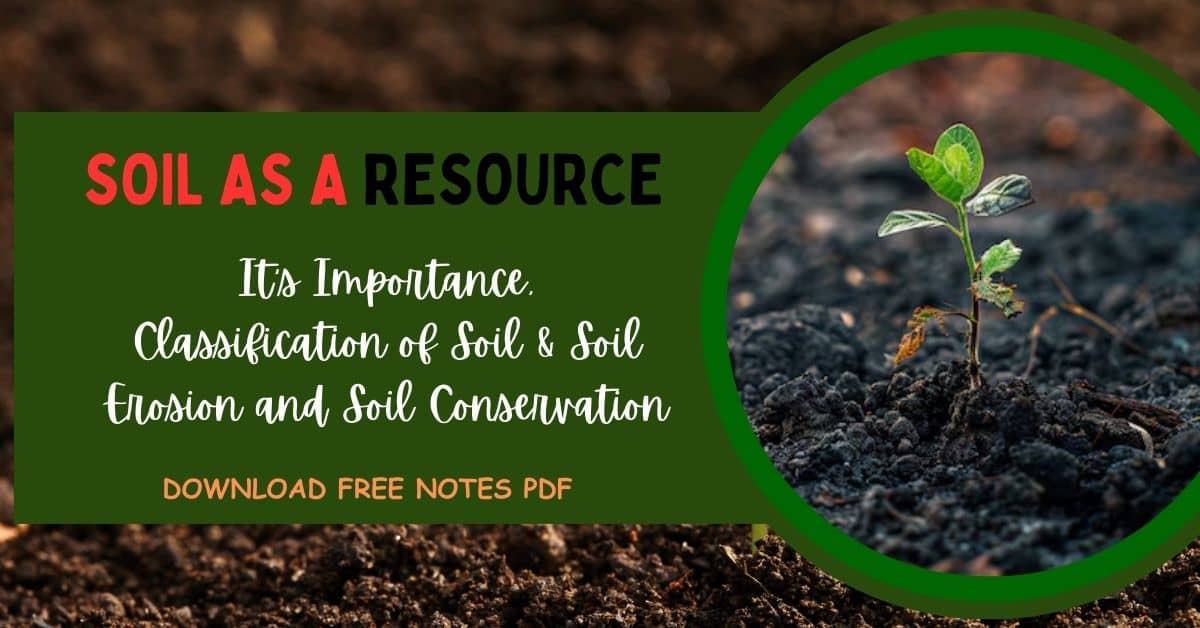NCERT Geography Class 10 | Soil As A Resource: Importance, Classification of Soil & Soil Erosion and Soil Conservation
Topic & sub-topics covered: Soil As A Resource, Its Classification, Soil Erosion and Soil Conservation: Resources and Development (All single detail notes are exam-oriented).
Soil As A Resource: Importance, Classification of Soil & Soil Erosion and Soil Conservation delves into the significance of soil as one of the most vital renewable natural resources. Soil supports plant growth, sustains diverse ecosystems, and plays a crucial role in agriculture, which is fundamental to human survival. This topic explores the different types of soils found across India, classified based on factors such as formation, texture, and fertility.
It highlights the difference between soil erosion and soil conservation, including both natural forces and human activities, which threaten soil health and agricultural productivity. The chapter also emphasizes the importance of soil conservation techniques like contour ploughing, terrace farming, and strip cropping to combat erosion and maintain soil fertility. Understanding these aspects helps students appreciate the need for sustainable land-use practices to protect this invaluable resource for future generations. In this blog, we will discuss “Soil As A Resource“.
Download the NCERT Geography for Class 10th Chapter 1 Resources and Development PDF
NCERT Geography for Class 10th Chapter 1 Resources and Development PDF offers students a comprehensive guide to understanding resources, their types, and sustainable management. Chapter 1: Resources and Development delves into natural, human, and human-made resources, emphasizing the need for careful utilization and conservation.
Download the NCERT Geography for Class 10th Chapter 1 Resources and Development PDF
It covers resource planning, conservation techniques, and the impact of technology on resource management. This PDF aligns with the CBSE curriculum, providing well-structured content for easy study and revision. The chapter emphasizes the balance between current resource use and preserving future needs, focusing on sustainable development principles.
Soil As A Resource
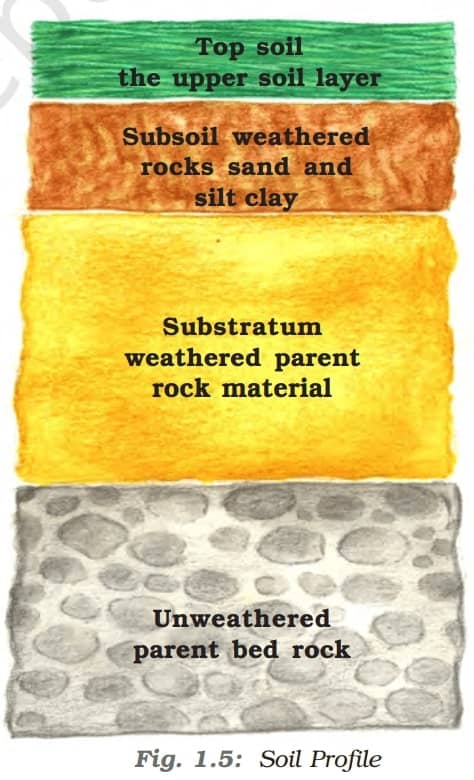
1. Importance of Soil:
- Soil is the most important renewable natural resource for plant growth and supporting diverse life forms.
- Soil is a living system that takes millions of years to form up to a few centimetres in depth.
2. Factors Contributing to Soil Formation:
- Key Factors: Relief, parent rock or bedrock, climate, vegetation, other life forms, and time are crucial in soil formation.
- Natural Forces: Temperature changes, running water, wind, glaciers, and decomposer activities contribute to the soil formation process.
- Chemical and Organic Changes: These changes in the soil are equally vital for its development.
3. Composition of Soil:
- Soil consists of both organic materials (humus) and inorganic materials.
4. Classification of Soils in India:
- Soils in India are classified based on factors such as the formation process, colour, thickness, texture, age, and chemical and physical properties.
Classification of Soil
India’s diverse relief features, landforms, climatic zones, and vegetation types have played a significant role in forming various soil types across the country.
Let’s understand the Classification of Soil in India:
I. Alluvial Soils:
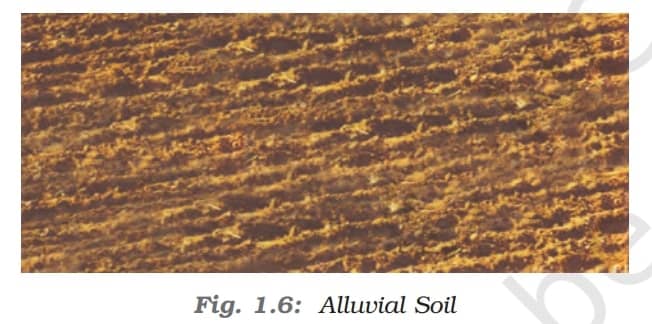
1. Distribution of Alluvial Soil:
- Alluvial soil is the most widely spread and important soil type in India.
- It predominantly covers the entire northern plains, deposited by the Indus, Ganga, and Brahmaputra river systems.
- This soil extends into Rajasthan and Gujarat through a narrow corridor.
- It is also found in the eastern coastal plains, particularly in the deltas of the Mahanadi, Godavari, Krishna, and Kaveri rivers.
2. Composition and Characteristics of Alluvial Soil:
- Alluvial soil consists of varying proportions of sand, silt, and clay.
- As you move inland towards river valleys, soil particles increase in size.
- Coarser soils are common in piedmont plains, such as Duars, Chos, and Terai.
3. Classification by Age:
- Alluvial soils are classified by age into old alluvial (Bangar) and new alluvial (Khadar).
- Bangar Soil: Contains a higher concentration of kankar (calcium carbonate) nodules and has coarser particles.
- Khadar Soil: Finer particles and more fertile compared to Bangar.
4. Fertility and Agricultural Suitability:
- Alluvial soils are generally very fertile and contain adequate potash, phosphoric acid, and lime.
- They are ideal for growing crops like sugarcane, paddy, wheat, and other cereals and pulses.
- Regions with alluvial soils are intensively cultivated and densely populated due to their high fertility.
- In drier areas, alluvial soils are more alkaline but can become productive with proper treatment and irrigation.
II. Black Soil:

1. Characteristics of Black Soil:
- The black soil, also known as regur soil or black cotton soil, is black.
- It is ideal for growing cotton, making it famously known as black cotton soil.
- The formation of black soil is influenced by climatic conditions and parent rock material.
2. Distribution of Black Soil:
- Black soil is typical of the Deccan Trap (Basalt) region formed from lava flows.
- It covers the plateaus of Maharashtra, Saurashtra, Malwa, Madhya Pradesh, and Chhattisgarh.
- The soil extends southeast along the Godavari and Krishna valleys.
3. Composition and Properties of Black Soil:
- Black soils are composed of extremely fine, clayey material.
- They have a high moisture retention capacity and are rich in nutrients like calcium carbonate, magnesium, potash, and lime.
- These soils are generally poor in phosphoric content.
4. Unique Features:
- Black soils develop deep cracks during hot weather, aiding in proper aeration.
- They become sticky when wet and are difficult to work on unless tilled immediately after the first shower or during the pre-monsoon period.
III. Red and Yellow Soils:
1. Formation and Distribution of Red and Yellow Soils:
- Red soil develops on crystalline igneous rocks in regions with low rainfall.
- It is primarily found in the eastern and southern parts of the Deccan Plateau.
- Red and yellow soils are also present in:
- Parts of Odisha and Chhattisgarh.
- Southern parts of the middle Ganga plain.
- Along the Piedmont zone of the Western Ghats.
2. Characteristics of Red and Yellow Soils:
- The red colour of the soil is due to the diffusion of iron from crystalline and metamorphic rocks.
- The soil appears yellow when it is in a hydrated form.
IV. Laterite Soil:
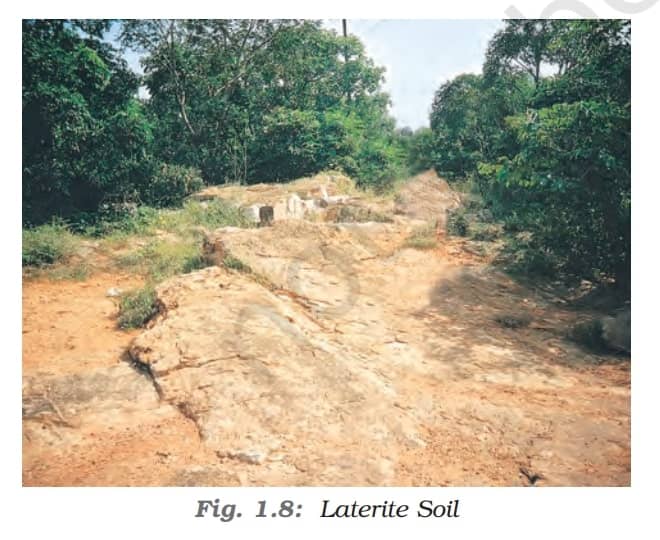
1. Origin and Formation of Laterite Soil:
- The term “laterite” is derived from the Latin word ‘later,’ meaning brick.
- Laterite soil develops under tropical and subtropical climates with alternate wet and dry seasons.
- It forms due to intense leaching caused by heavy rainfall.
2. Characteristics of Laterite Soil:
- Lateritic soils are generally deep to very deep and acidic with a pH less than 6.0.
- These soils are typically deficient in plant nutrients.
- In regions with deciduous and evergreen forests, laterite soil is rich in humus; however, it is humus-poor in semi-arid areas with sparse vegetation.
- They are prone to erosion and degradation due to their landscape position.
3. Geographical Distribution of Laterite Soil:
- Laterite soils are found in southern states, the Western Ghats region of Maharashtra, Odisha, parts of West Bengal, and the North-eastern regions of India.
4. Agricultural Uses:
- With proper soil conservation techniques, particularly in hilly areas of Karnataka, Kerala, and Tamil Nadu, laterite soil is suitable for growing tea and coffee.
- Red laterite soils in Tamil Nadu, Andhra Pradesh, and Kerala are more suitable for cultivating crops like cashew nuts.
V. Arid Soils:
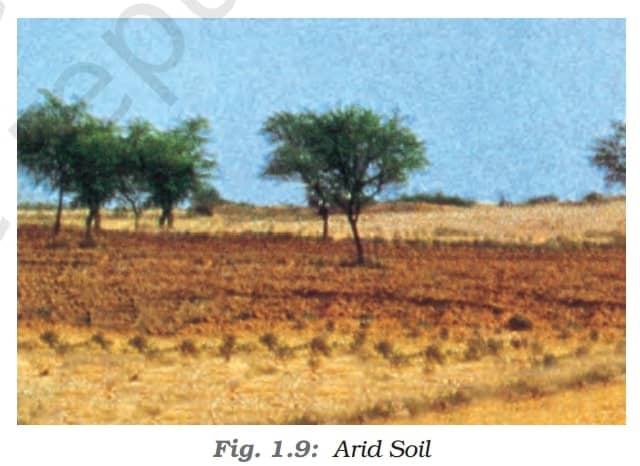
1. Characteristics of Arid Soils:
- Arid soils range in colour from red to brown.
- They generally have a sandy texture and are saline.
- Some areas have high salt content, where common salt can be obtained through the evaporation of water.
- These soils lack humus and moisture due to the dry climate and high temperatures, which accelerate evaporation.
- The lower horizons contain Kankar due to the increasing calcium content, forming a hard layer.
2. Challenges and Solutions:
- The Kankar layer in the lower horizons restricts water infiltration, posing challenges for agriculture.
- With proper irrigation, arid soils can become cultivable, as demonstrated in western Rajasthan.
VI. Forest Soils:
1. Characteristics of Mountain Soils:
- Mountain soils are found in hilly and mountainous areas with sufficient rainforests.
- The texture of these soils varies according to the mountain environment:
- Loamy and silty on valley sides.
- Coarse-grained on the upper slopes.
- In snow-covered areas of the Himalayas, these soils experience denudation and are acidic with low humus content.
- Soils in the lower parts of valleys, especially on river terraces and alluvial fans, are fertile.
Soil Erosion and Soil Conservation
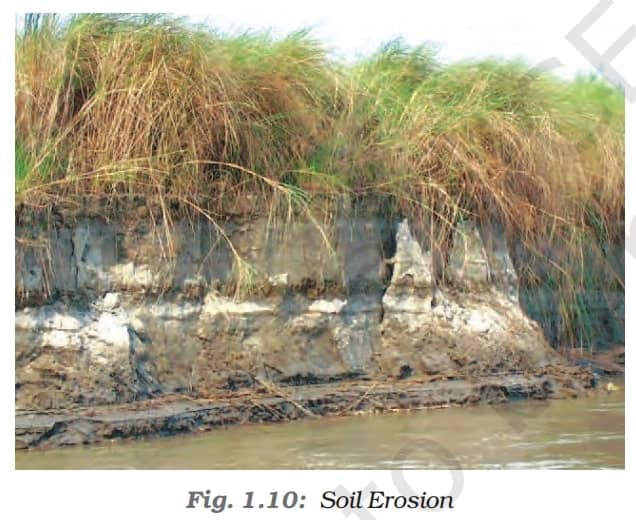
Differentiate between soil erosion and soil conservation:
Let’s understand the difference between soil erosion and soil conservation with the help of these pointers.
1. Soil Erosion and Its Causes:
- Soil Erosion Definition: Denudation of soil cover and washing down of soil is termed soil erosion.
- Balance of Soil Formation and Erosion: Normally, soil formation and erosion occur simultaneously in a balanced manner.
- Disturbance of Balance: This balance can be disturbed by human activities like deforestation, over-grazing, construction, and mining.
- Natural Causes of Erosion: Natural forces such as wind, glaciers, and water also contribute to soil erosion.
- Gully Erosion: Running water cuts through clayey soils, forming deep channels known as gullies; affected lands are termed badlands (e.g., ravines in the Chambal basin).
- Sheet Erosion: Occurs when water flows as a sheet over large areas, washing away the topsoil.
- Wind Erosion: Wind blows loose soil off flat or sloping land, leading to soil erosion.
- Defective Farming Methods: Ploughing up and down the slope forms channels that accelerate water flow, increasing erosion.
2. Soil Conservation Methods:
- Contour Ploughing: Ploughing along contour lines slows down the water flow, reducing erosion.
- Terrace Cultivation: Cutting steps on slopes restricts soil erosion, as seen in the western and central Himalayas.
- Strip Cropping: Dividing large fields into strips with grass between crops breaks wind force, reducing erosion.
- Shelter Belts: Planting rows of trees creates barriers against wind, stabilizing dunes and deserts in western India.

